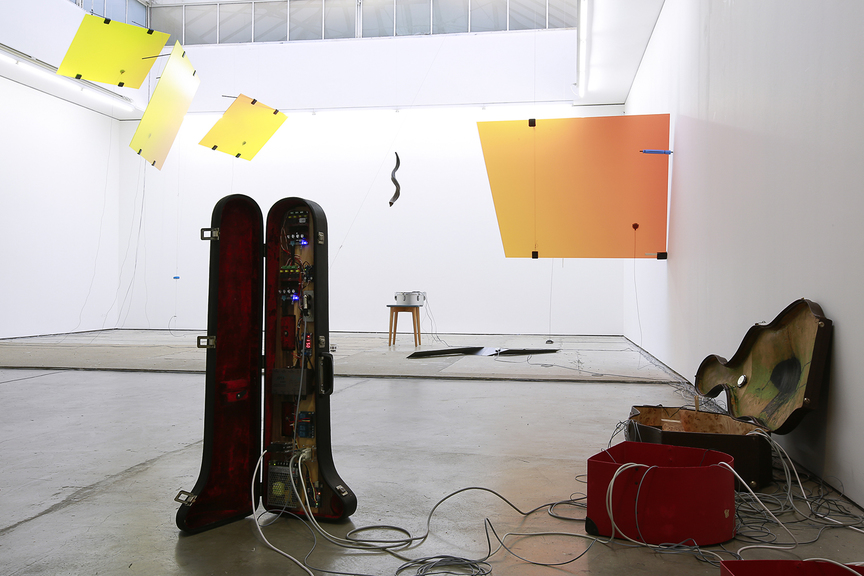-
From Current Issue
-
- Editor’s Letter Fire in the Heart
- Reviews I Gusti Ayu Kadek Murniasih
- Reviews 11th Seoul Mediacity Biennale: “One Escape at a Time”
- Dispatch Networked China
- One on One Monira Al Qadiri on Yukio Mishima
- Essays The rise of independent art spaces in pandemic-era Shanghai
- Features Tuan Andrew Nguyen
- Table of Contents
- Web Exclusives
- Archive
- Subscribe

R
E
V N
E
X
T
Installation view of TAMAR HARPAZ’s Crazy Delay, 2018, sound and kinetic installation; 4 mins 56 secs, at “Tamar Harpaz: Crazy Delay,” Edel Assanti, London, 2018. All images copyright Studio Will Amlot, courtesy Tamar Harpaz and Edel Assanti, London.
The trouble with transposition is that, in the act of converting something into a new key, context or language, information is inevitably lost. When the process is unsuccessful, and essential attributes are stripped away, the residual product is a pale shadow of the original. However, many phenomena are beset with superfluity, and, at its best, a transposition sheds them of all but their essence, leaving a vivid, affecting emotional core. Such is the case with Tamar Harpaz’s new installation, Crazy Delay (2018), at London’s Edel Assanti gallery.
The work represents the final iteration in a chain of transpositions between radically different “media,” beginning—as do many of the artist’s works—with a dream. Having formerly struggled with the difficulties of life as a female artist in Israel, Harpaz is now settled with her family in Amsterdam, but the dissonant sensation of being away from one’s native home, and not fully belonging to an adoptive one, finds its way frequently into her sleepinghours. The first transposition, therefore, is from the obscure vision of one of her dreams into a text, copies of which accompanied the installation. “It feels like being covered with soil,” her oneiric synopsis begins. “I can taste the limestone in my mouth, my ears are full, my eyes heavily closed shut.” And the sense of anxiety deepens with an insightful allusion to the familiar obstacles dreams can subject us to, where a slight adjustment of reality or logic frustrates our objectives: “I typed: ‘74A Newman St., London’ [the address of Edel Assanti] into Google Maps. ‘Could not find the way there’ appeared on my screen.”
Installation view of TAMAR HARPAZ’s Crazy Delay, 2018, sound and kinetic installation; 4 mins 56 secs, violin case, rock, electroluminescent wire, drum box, wood, aluminum, string, metal case, blue silicone disc, UV prints on glass, bass guitar strings, tea cup, snare drum, stool, shofar, spoon, wood, string, steel, cello case, trombone case, flight cases, muzuza, contact microphones, electronic components, dimensions variable.
In her waking life, though, Harpaz did make it to the gallery, and mounted an installation that aptly captures the anxiety of the dream-turned-text, but also its other elements: the beauty in her remembered image of a conceptual artist placing plants in a salt lake, a sombre recounting of burial instructions, and a sense of musicality and language, as her heartbeat becomes a tap, the tap a code, and the code like “letters forming words,” before she describes hearing her own voice singing. In this final transposition, spread out across the whole of the gallery’s ground floor, Harpaz created an intricate, immersive, delicately narrative piece, the elusive meaning of which unfolds not through description—as in the text that preceded it—but the creation of an emotionally charged, multi-sensory environment. A series of objects—the string of a double bass, instrument and flight cases, glass plates bearing UV prints, rocks, aluminum and sheets of steel—are all connected by wires and complex electronics, and as these spur the items to movement, sound is also produced.
In the intersection of these objects, their movements and their sounds, looping every 4 minutes and 56 seconds, a picture of homes lost and sought, anxiety, nostalgia, and familiarity begins to emerge. A teacup on the ground, apparently taken from the artist’s former house, emits the muffled ringing of a telephone, and then the voice of a friend leaving a voicemail when there is no answer. The sound of a beating heart—belonging to one of Harpaz’s two children—plays from a sheet of zig-zagging steel nearby. Soon, one hears a harmonious sequence of guitar chords recorded by the artist’s husband, but they are followed by more dissonant sounds—scraping strings and atmospheric noise passed through distortion pedals and corrupting circuitry, arranged in cases meant to contain musical instruments.
Remarkably, none of the noises that culminate in this moving soundscape are created by conventional speakers. Instead, the teacups, plates and wires themselves amplify the signals passed to them, marking a further, conscious transposition—from dream to text, and then from object to kinesis, and finally to sound. Much information has necessarily been lost in this process. The details of a dream forgotten in the moments between waking and noting them are, by themselves, significant. But standing in the midst of Harpaz’s creation, where words, objects, movements and noises have all blurred into each other, there remains something of the intuitive, wistful feeling of a dream of home upon waking.
Tamar Harpaz’s "Crazy Delay" is on view at Edel Assanti gallery, London, until April 21, 2018. A video of the installation is available here.
To read more of ArtAsiaPacific’s articles, visit our Digital Library.





